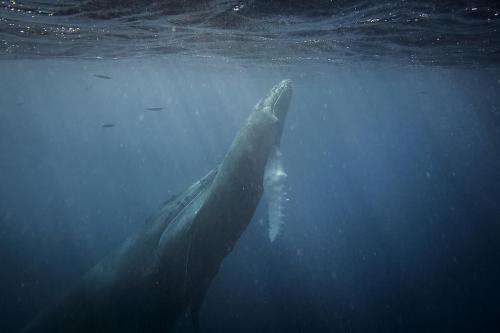Australian humpbacks challenge breeding grounds assumption

Humpback whales from WA are mixing with those on the east coast of Australia and are genetically similar despite their breeding grounds being 2500km apart.
A genetic study of the west coast and east coast populations of humpbacks (Megaptera novaeangliae) found little difference between the two, even though WA humpbacks breed off the Kimberley coast while east coast humpbacks are thought to mate and calve at the Great Barrier Reef.
Centre for Whale Research managing director Curt Jenner says it is likely the whales are mixing at summer feeding grounds near Antarctica and may be attracted across the country by food or mates.
"The breeding grounds are obviously very separate but when they go down to the feeding grounds it becomes a bit muddy," he says.
"Because Antarctica's a continent that you can circumnavigate if you're a whale, just by swimming around in a season, it's quite easy for those populations to mix."
Mr Jenner says on a trip south of Australia in January he saw east coast and west coast humpbacks separated by only about 500 miles (800km).
"If you're a whale swimming that distance it would only take you a week to cross between population boundaries," he says.
The finding, published in Marine Mammal Science, is supported by research into whale songs in the 1990s that suggested WA humpbacks could swim to the east coast.
The scientists compared samples collected from 131 individual whales off the coast of Tasmania and New South Wales and a further 205 whales off Exmouth.
Mr Jenner, who supplied material for genetic testing from the WA humpbacks, says samples are taken using an air rifle like that used by vets to shoot tranquilliser darts.
"Instead of a dart which would inject an anaesthetic into the animal, we actually just have a hollow tip on the end of the dart," he says.
"It just takes a little plug of skin, probably about 2mm in diameter and about 20mm long."
The researchers slowly pace alongside the whale until the animal is comfortable with the sound of the vessel, wait until the whale comes to the surface and then line up for a shot.
Mr Jenner says it is possible humpbacks are also using Antarctic waters to migrate between Australia and other continents.
"[That's] the next premise, that these whales not only are travelling between eastern and western Australia but they're probably also moving into the South Pacific and maybe across to South America and then from South America perhaps across to Africa," he says.
"Those linkages have yet to be made but it's not impossible that that's what's going on."
More information: Schmitt, N. T., Double, M. C., Jarman, S. N., Gales, N., Marthick, J. R., Polanowski, A. M., Scott Baker, C., Steel, D., Jenner, K. C. S., Jenner, M.-N. M., Gales, R., Paton, D. and Peakall, R. (2014), "Low levels of genetic differentiation characterize Australian humpback whale (Megaptera novaeangliae) populations." Marine Mammal Science, 30: 221–241. doi: 10.1111/mms.12045
Journal information: Marine Mammal Science
Provided by Science Network WA


















